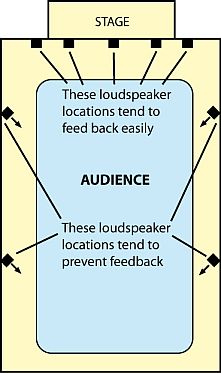Preventing Feedback with Floor Mics (using the PAG/NAG equation)
Feedback is a major issue with floor mics and hanging mics. Fortunately, the PAG-NAG equations* can help us design a sound system that maximizes gain-before-feedback. Those equations predict the gain-before-feedback of a sound system based on the mic placement, speaker placement, and number of open microphones.
As shown by the PAG-NAG equations, loudspeakers over or near the stage tend to cause feedback with microphones that are far from the sound source, such as floor mics and hanging mics. That's because the loudspeakers are relatively close to the mics and far from the audience. Both factors reduce gain-before-feedback. Then why are many auditoriums designed with the loudspeakers over or near the stage? That placement helps listeners localize sound near the stage, and tends to provide uniform SPL coverage of the audience. Such sound systems are designed mainly for close-miked performances, in which feedback is not a serious problem. However, distant miking with floor mics or hanging mics requires a different loudspeaker placement to minimize feedback.
According to the PAG-NAG equations, gain-before-feedback can be increased by placing the loudspeakers close to the audience and far from the microphones. A venue's existing speaker placement might work fine. But if you have trouble with feedback, it can help to buy, borrow or rent two portable PA speakers and speaker cables so you can place the speakers for maximum gain-before-feedback.
You might start with just two speakers and place them near the side walls, even with the third row from the front, aiming diagonally across the audience. That’s an effective placement for reducing feedback, and it makes floor mics a viable option for amplifying actors in a theater. If the sound is too quiet at the back of the theater, add two more speakers farther back. Consider adding delays.

As a side benefit, the direct-to-reverb ratio of the loudspeakers' sound increases as you place the loudspeakers closer to the listeners. That improves intelligibility by reducing the perceived reverberation which smears syllables.
Of course, that speaker placement is a particular compromise aimed at getting the most loudness and highest direct-to-reverb ratio to the listeners, at the expense of other factors. But sometimes the most important goal is just to hear and understand the words of the actors.
It also helps to reduce the number of open microphones by riding the mixer faders to follow the action on stage. Ideally only one mic is turned up at a time. That increases gain-before-feedback, reduces phase interference between mics, and reduces the amount of room acoustics picked up by the mics.
If you don't want the complication and expense of using several headworn wireless mics, try floor mics with the recommended loudspeaker placement. That system can work surprisingly well.
*Gain-before-feedback calculator based on the PAG-NAG equations:
http://cdn.shopify.com/s/files/1/0247/3799/files/feedback_calculator.pdf?1696
Article on unidirectional boundary mics:
http://cdn.shopify.com/s/files/1/0247/3799/files/directional_boundary_mics_1.pdf?1581
